Chap 13 Interspecific competition
1/62
There's no tags or description
Looks like no tags are added yet.
Name | Mastery | Learn | Test | Matching | Spaced |
|---|
No study sessions yet.
63 Terms
interspecific competition
(BOOK/NOTES)
- a relationship that affects the populations of 2 or more species adversely
----------------
RELATIONSHIP
(-,-)
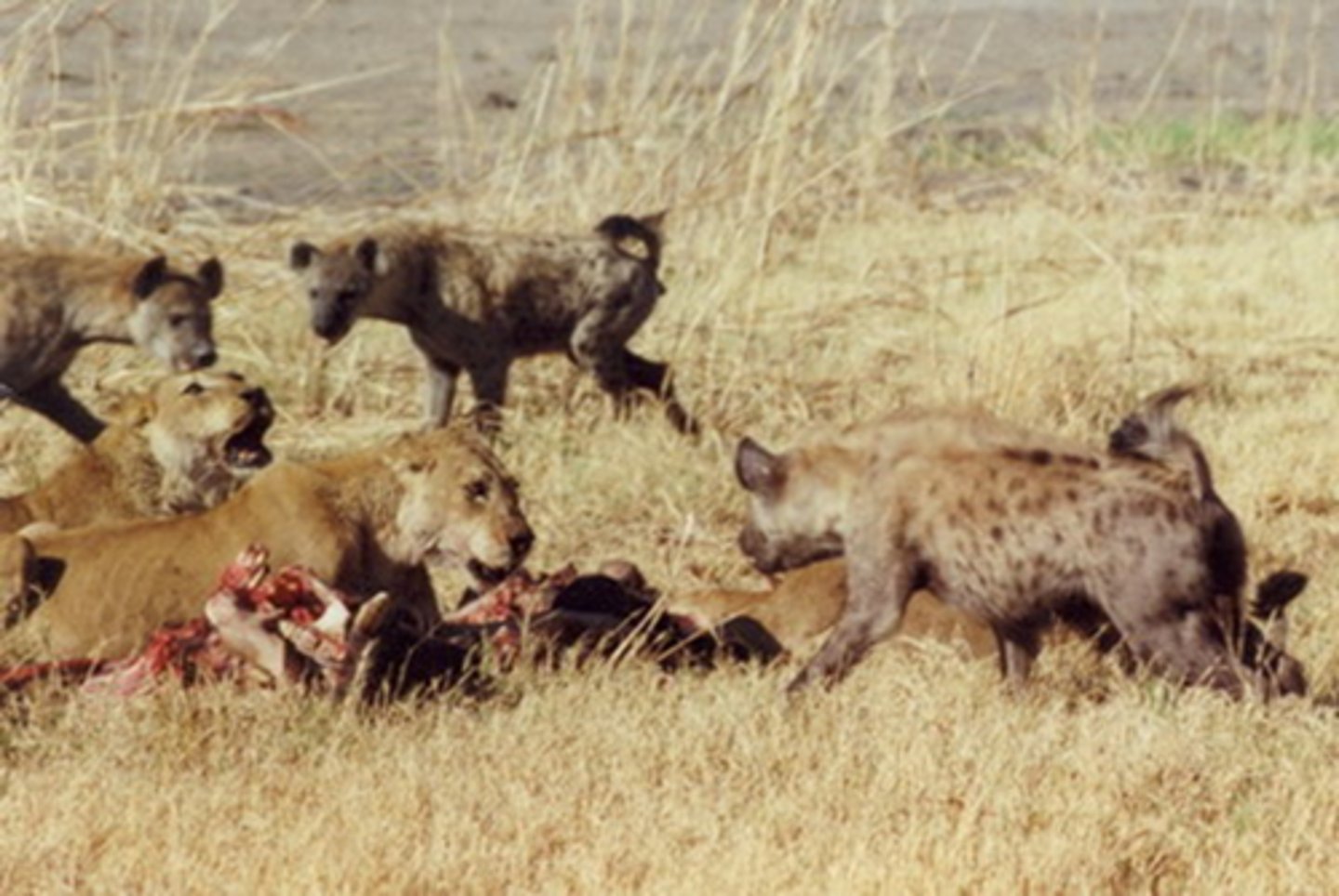
Intraspecific and interspecific competition
(LEC)
- may occur simultaneously
----------------
(BOOK)
- individuals seek a common resource in short supply (BOTH)
- individuals are of two or more species (inter)
----------------
EX: Deciduous forest of Eastern North America
Deciduous forest of Eastern North America (inter. and intra. comp.)
INDIVIDUAL COMPETITIONS:
- gray squirrels compete among themselves for acorns during a year when oak trees produce fewer acorns
----------------
SPECIES COMPETITIONS:
- gray squirrels will also compete with other species for acorns
- species include: white-tailed deer, wild turkeys, white-footed mice, blue jays
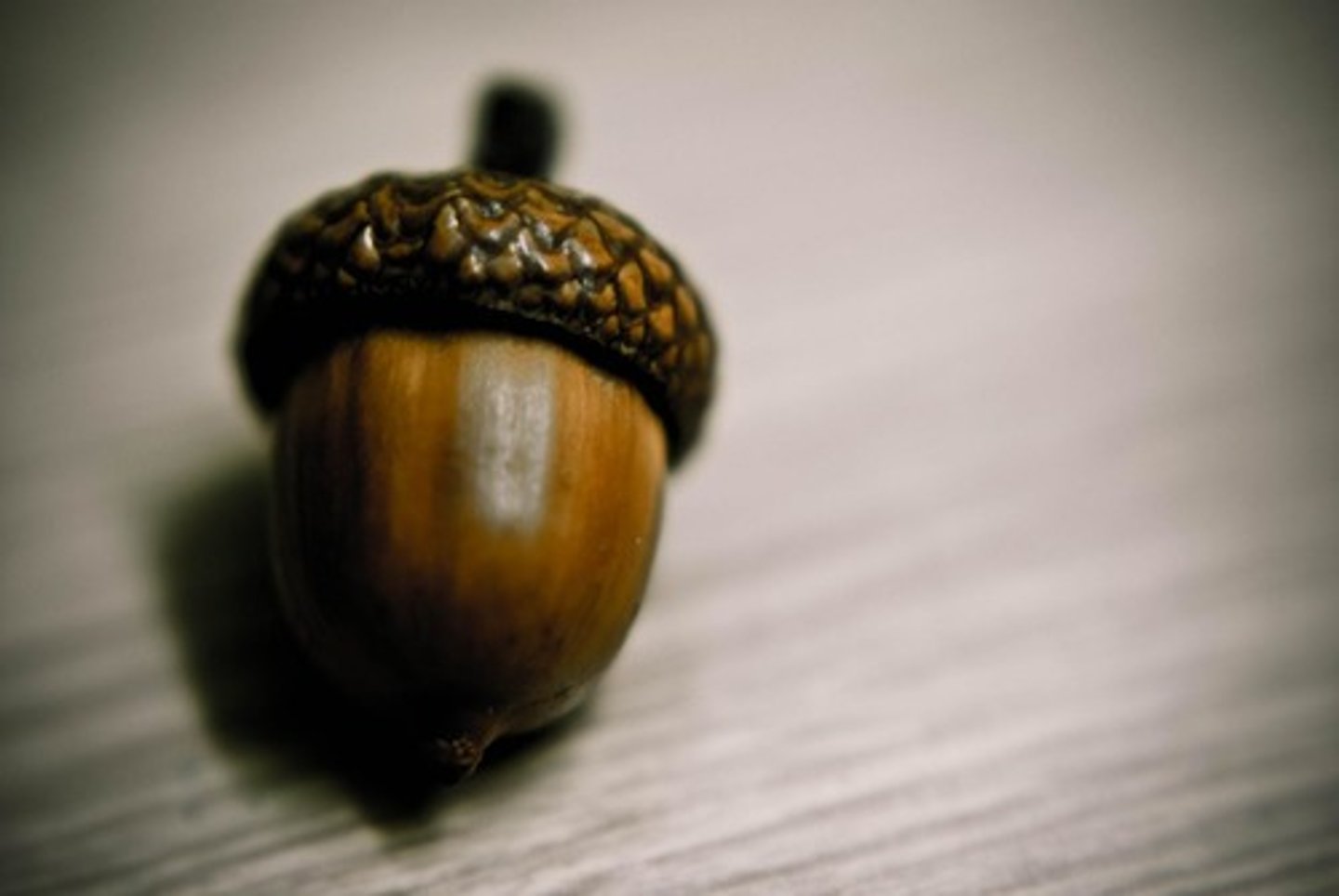
species competitions (within deciduous forest East N.A)
competition between one or more the species may broaden the base of their foraging efforts
- populations of theses species may be forced to turn away from acorns to food that is less in demand
logistic growth equations for two competing species
Species 1:
dN1/dt = r1N1 (1-N1/K1)
----------------
Species 2:
dN2/dt = r2N2 (1-N2/K2)
competition coefficient
coefficients that take in account for competitive effect of one species on the population growth of the other
- is added to either N1 or N2
----------------
TYPES:
α (alpha)
β (beta)
α (alpha) competition coefficient
quantifies the per capita effect of species 2 on species 1

β (beta) competition coefficient
quantifies the per capita effect of species 1 on species 2

factors of competition coefficient
(LEC/BOOK)
- they are factors for convert in an individual of one species into the equivalent # of individuals of the competing species
----------------
WHAT IS IT BASED ON?
- their shared use of resources that define the carrying capacity (K)
Species 1 (αN2)
accounts for the competitive effect of species 2 on species 1
----------------
EQUATION:
dN1/dt = r1N1 (1-(N1+αN2)/K1)
----------------
WHAT DOES EQUATION MEAN?
- models the population growth for species 1
Species 2 (βN2)
accounts for the competitive effect of species 1 on species 2
----------------
EQUATION:
dN2/dt = r2N2 (1-(N2+βN2)/K2)
----------------
WHAT DOES EQUATION MEAN?
- models the population growth for species 2
Herbivores feeding on the same plant (EXAMPLE)
ASSUME:
- species 2 (elk) has a body mass thats 2x as big as Species 1 (deer)
- species 2 consumes 2x the rate as species 1 (one elk = two deer)
----------------
WHAT DOES THIS MEAN?
- impact of an species 2 (elk) on species 1 (deer) would be α = 2.0 (consumes 2x as much as deer and is 2x bigger)
- impact of species 1 (deer) on species 2 (elk) would be β = 0.5 (consumes half the rate of elk)
absence of interspecific competition (EX: elk vs deer)
- Either α or N2 = 0 in equation 1
- Either β or N1 = 0 in equation 2
----------------
WHAT DOES THIS MEAN?
- the population of each species will grow logistically to equilibrium at K (respective carrying capacity)
Presence of competition (EX: elk vs deer)
FOR DEER:
carrying capacity for deer is K1 and as N1 approaches K1, the population growth (dN1/dt) approaches 0
----------------
FOR ELK:
ELK is also vying for the limited resource that determines K1, so we must consider the impact of species 2. Because α is the per capita effect of species 2 on species 1, the total effect of species 2 on species 1 is aN2, and as the combined population N1 + aN2 approaches K1, the growth rate of species 1 approaches zero as well.
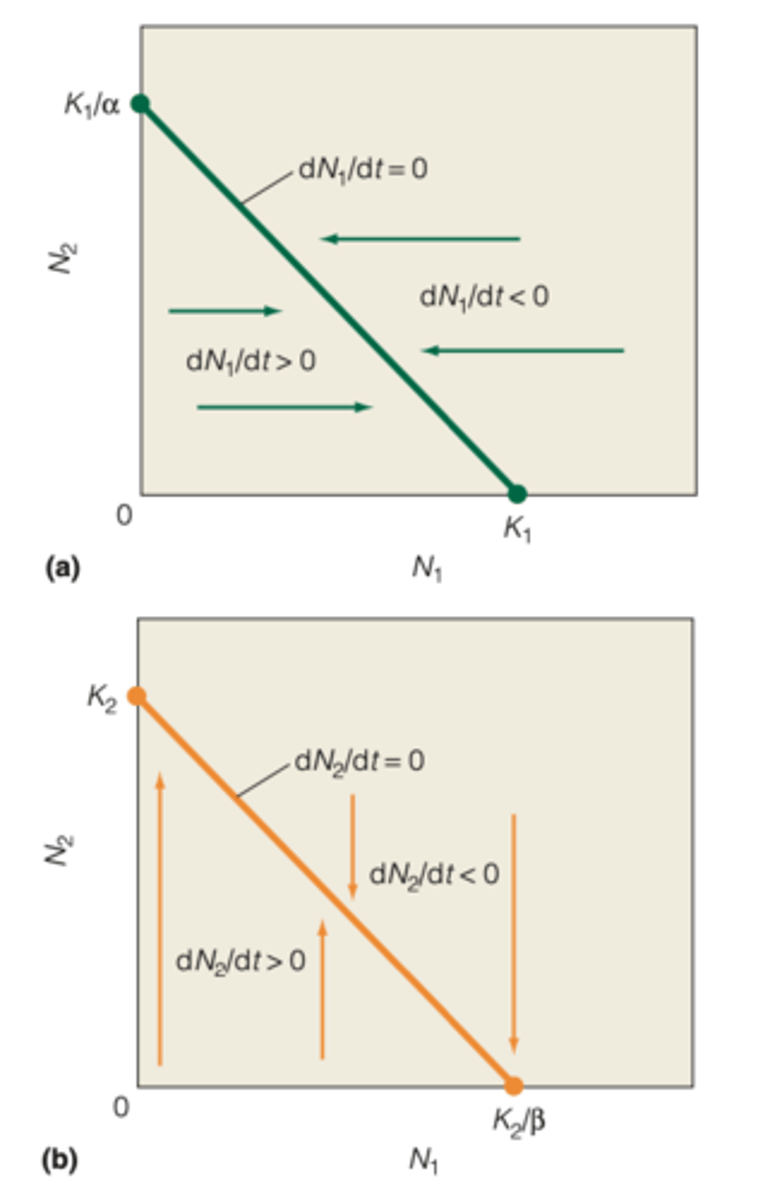
Presence of competition for ELK ONLY
WHAT DOES THIS MEAN
- the greater the population size of elk (N2) or the greater the competitive effect (α) , the greater the reduction in the growth rate of deer
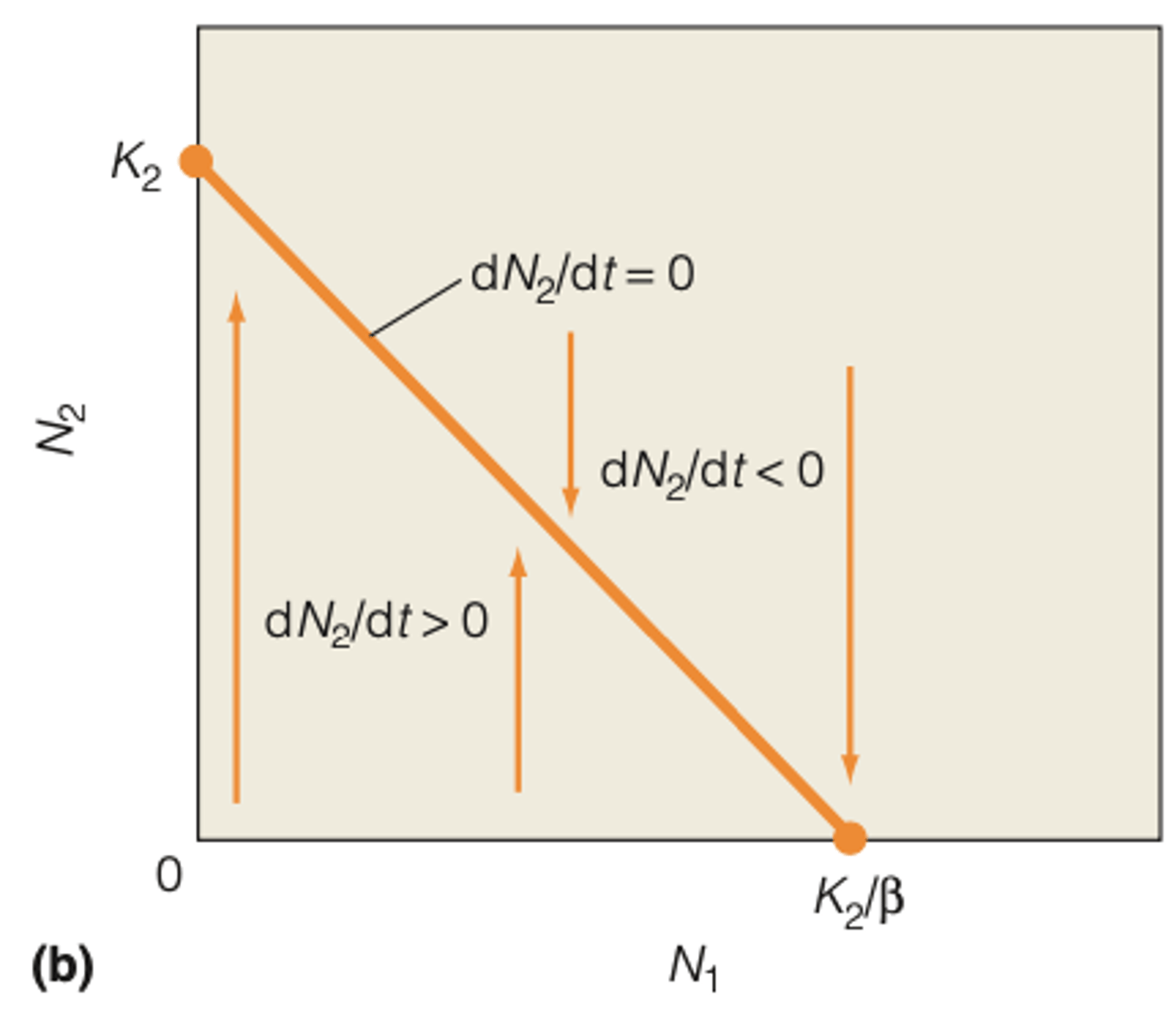
Lotka-Volterra Model
the model used to examine the possible outcomes of competition
- is a graphical approach in which you first define the zero growth isocline for each of the two competing species
zero growth isocline
represents the compined values of population size for species 1 (N1) and species 2 (N2) at which the population growth rate of the respective species is zero
(dN1/dt and dN2/dt = 0)
when does the zero growth isocline occur
occurs when the combined population sizes are = to the carrying capacity of that species
----------------
population size is = to K1 for species 1
population size is = to K1 for species 2
Zero growth isocline (species 1)
AXIS:
- N1 on the x-axis (Species 1)
- N2 on the y-axis (Species 2)
----------------
WHAT NOW?
- solve for the combined values of N1 and N2 at which growth rate (dN1/dt) = 0
----------------
THIS OCCURS WHEN
- (1-(N1+αN2/K1) = 0
or
- K1=N1+αN2
----------------
WHAT NOW?
- determine the combined values of N1 and N2 that equal the carrying capacity of species 1 (define the line by solving for the x- and y- intercepts)
----------------
ONCE SOLVED:
- x- intercepts is N2= 0, so N1=k1
- y- intercepts is N1= 0, so N2 = k1/α
----------------
For combinations of (N1, N2)
- below the line, spcies 1 growth rate will be positive
- above the line, species 1 growth rate will be negative
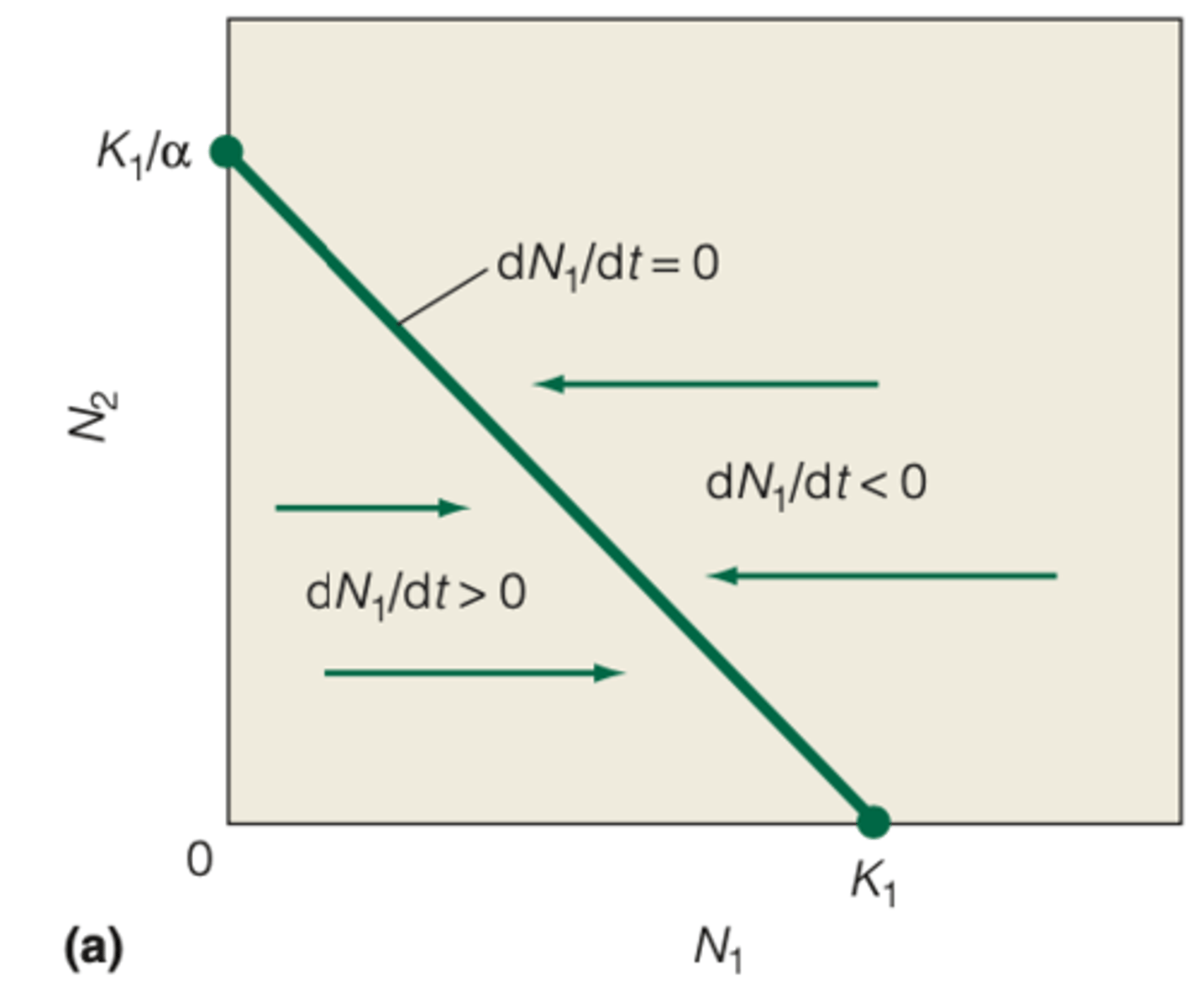
zero growth isocline (species 2)
AXIS:
- N1 on the x-axis (Species 1)
- N2 on the y-axis (Species 2)
----------------
WHAT NOW?
- solve for the combined values of N1 and N2 at which growth rate (dN1/dt) = 0
----------------
As with the zero-growth isocline for species 1, for combinations of N1 and N2 that fall below the line, N2 + βN1 < K2 and the population of species 2 can continue to grow.
----------------
OCCURS WHEN
THIS OCCURS WHEN
- (1-(N1+βN1/K1) = 0
or
- K1=N1+βN1
----------------
WHAT NOW?
define the line by solving for the x- and y- intercepts
----------------
ONCE SOLVED:
- x- intercepts is N2= 0, so N1=k2/β
- y- intercepts is N1= 0, so N2 = K2
exponential population growth model equation
dN/dt = rN
logistic population growth model equation
dN/dt= rN(1-N/K)
logistic with competitor growth model uses
USES:
- used to determine the effect of species 2 on the population growth rate of species 1
(dN1/dt = r1N1 (1- (N1 + N2)/K1))
- can be used to determine the carrying capacity of species 1 based on population sizes of species 1 and 2, as well as the competitive coefficient of species 2
(K1 = N1 + αN2)
competitive exclusion principle
ASSUMPTION:
"complete competitors cannot coexist"
----------------
MEANING:
- Complete competitors are two species (non-interbreeding populations) that live in the same place and have exactly the same ecological requirements
factors that affect the outcome of interspecific competition
- environmental factors (not resources) that influence survival, growth, and reproduction of species (temp and pH)
- spatial and temporal variation in resource avalability
- competition for multiple limiting resources
- resource partitioning
asterionella formosa and synedra ulna (BEETLES EXAMPLE)
researchers monitored the population growth and decline as well as the level of silica in water
----------------
OBSERVATIONS:
- when grown alone in a liquid medium to which silica was continually added, both species kept silica at a low level because they used it to form cell walls
- when grown together the silica by S. ulna reduced the conceration to a level below that necessary for A. formosa to survive and reproduce. By reducing resource availability, S. ulna drove A. formosa to extinction
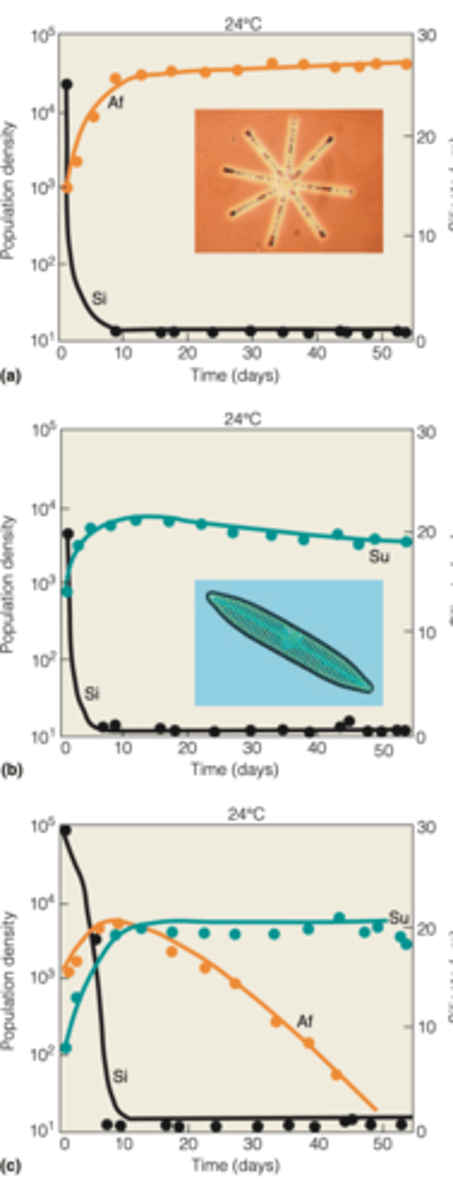
interspecific competition involves
individuals of two or more species vying for the same limited resource
- limiting resources may exclude other species
how does environmental conditions affect interspecific competition
features of the environment other than resources can directly influence the growth and reproduction of a species and therefore influence the outcome of competitive interactions
----------------
- competitive advantages of species may shift
what happens if the environmental conditions start to favor one species than the other
IF CONTINUOUS
- no one species may reach sufficient density to displace its competitor
What do environmental variation allow for
allows for competitors to coexist whereas under constant conditions, one would exclude the other
----------------
EX: grass species in Southern Africa
Grass species (EXAMPLE)
OBSERVATION:
- shift in dominance was a result of yearly variations in rainfall
----------------
TREND
- with less rain fall Urochloa M. would have higher rates of survival
- with more rain Heteropogon C. would have higher rates of survival while Urochloa would start to decrease.
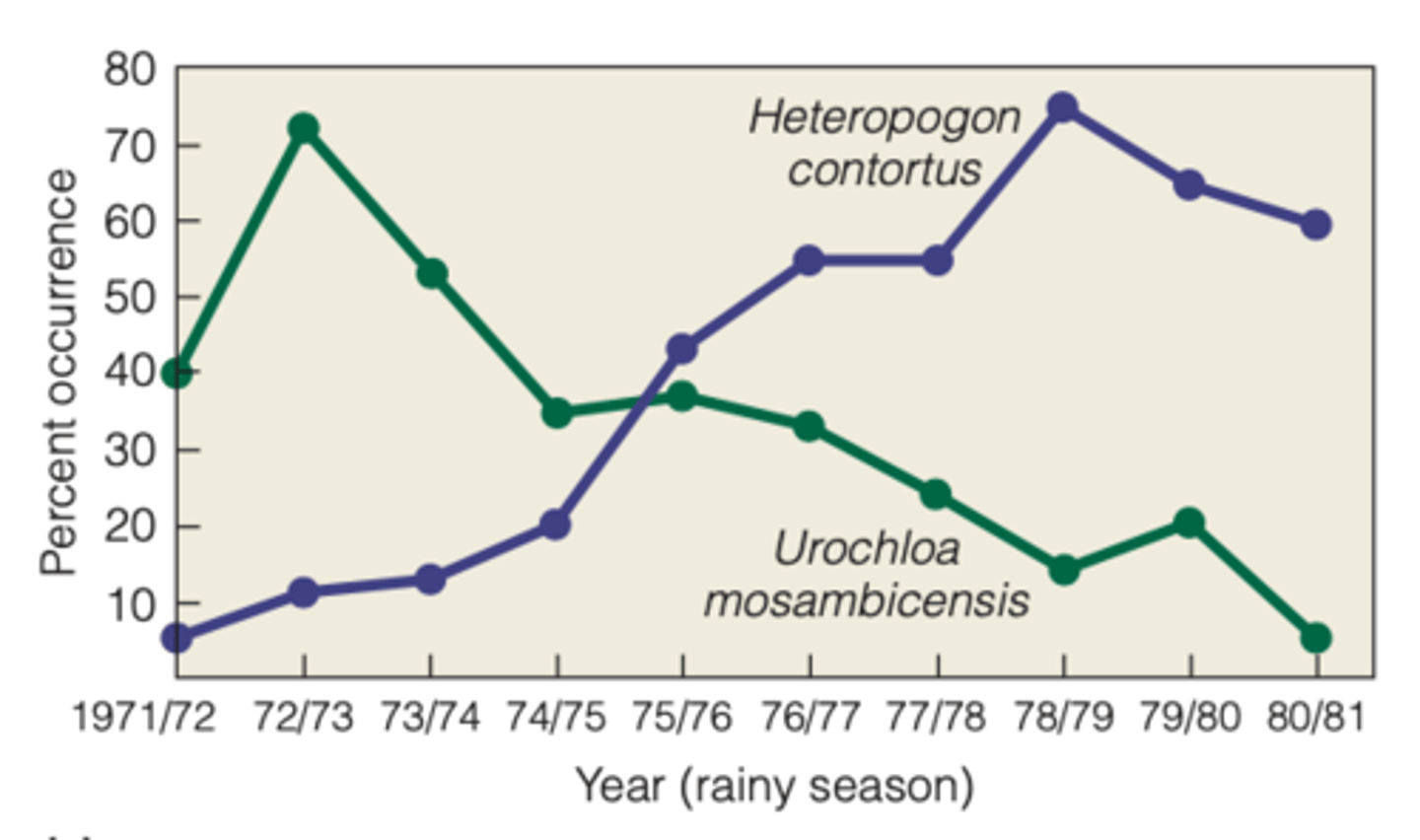
What might have influence the shift in competition outcome? (Grass species example)
It was based on the amount of rainfall that was occurring throughout each year
- there was a dynamic shift between both species which was dependent on the amount of rain and the time

variation of climate
can function as a density-independent limitation on population growth
----------------
HOW?
- periods of drought or extreme temperatures may depress the populations size below carrying capacity (K)
Competition between species involves
multiple resources and competition for one resource often influence an organisms ability to access other resources
----------------
EXAMPLES:
- interspecific territoriality
interspecific territoriality
GENERAL IDEA:
- competition for space influences access to food and nesting
----------------
MOST COMMONLY SEEN IN:
- birds in temperate and tropical communities
what does interspecific territoriality involve
the defense of territories against closely related species or much broader range of potential competitiors
----------------
RELATED SPECIES EX:
- gray vs dusky flaycatchers
----------------
BRODER RANGE SPECIES EX:
- acorn woodpeckers vs other woodpeckers, blue jays, and squirrels
Competition in plants
competition for one resource can influence the ability of an individual to exploit other resources, affecting survival and growth rates
what resources do plants compete for?
above ground = sunlight
below ground = nutrients soil (nutrients and water)
how to test competition in plants
increase either the above or below ground nutrients and allow the plants to fight over the other respective resource.
----------------
WHAT YOU SHOULD NOTICE:
- one plant will grow slowly while the other grows faster (indication the faster growing plant took the respctive resource)
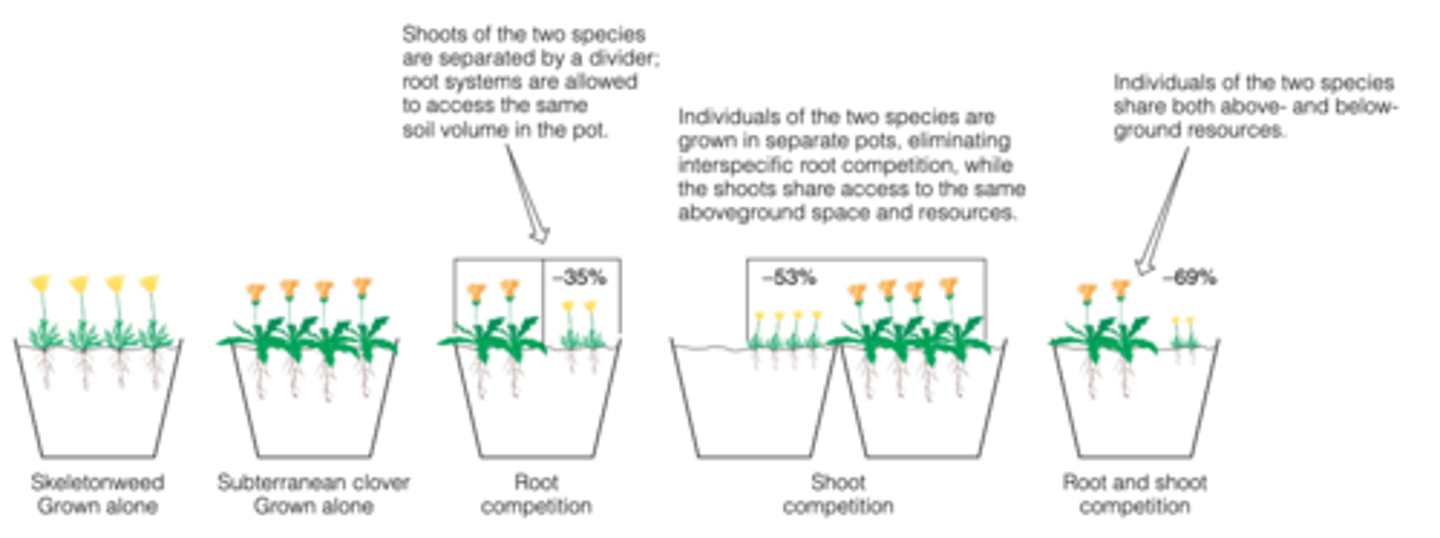
shifts in competitive ability can result from either
- changes in carrying capacities of species related to a changing resource base
or
- changes in the physical environment that interact with resource availability
----------------
CAN BE EXAMINED FOR BOTH PLANTS AND ANIMALS
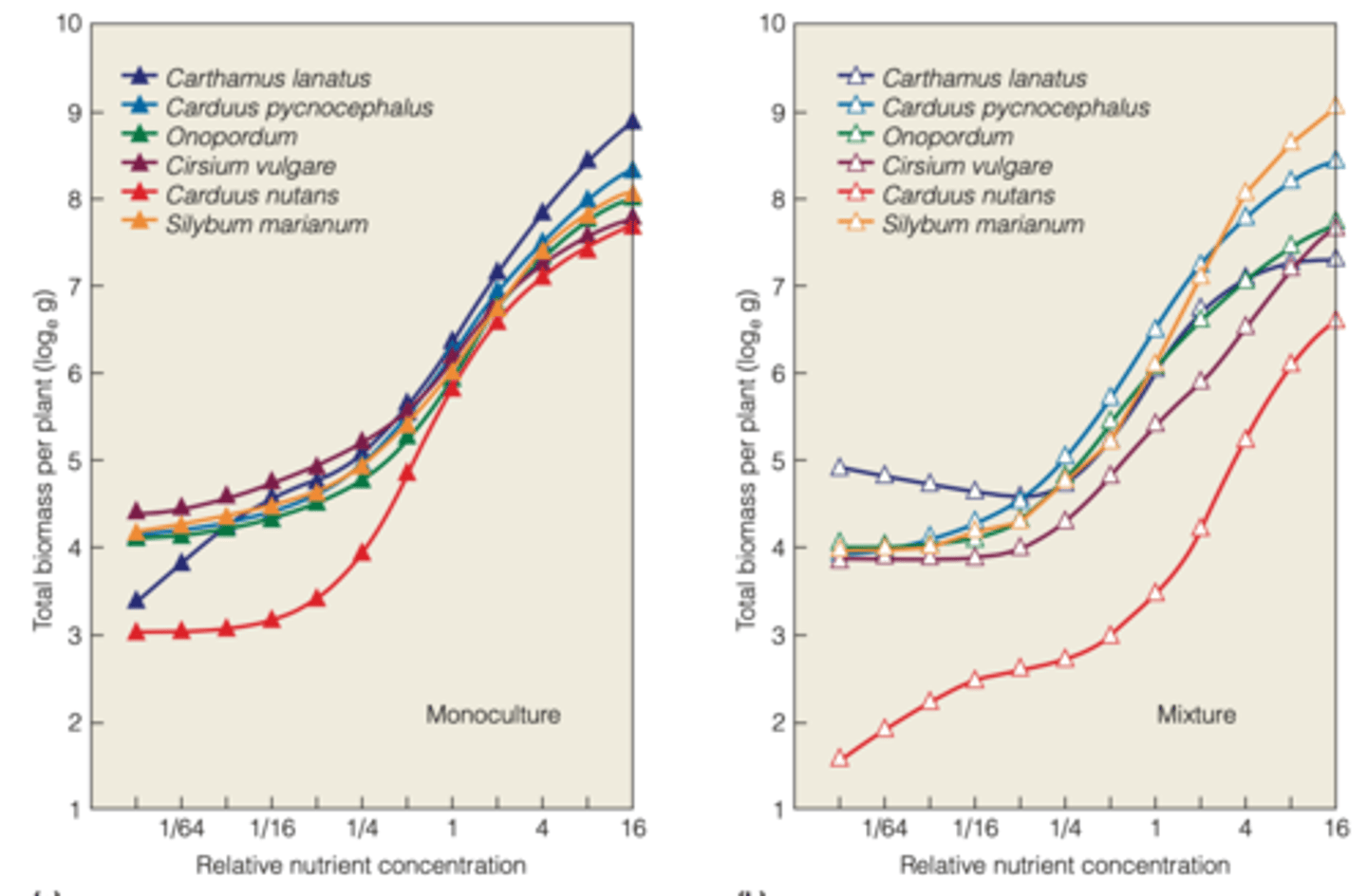
Shifts in competitive ability (EXAMPLE)
thistle plants grown in mixed culture showed lots of variation
- the competitive abilities changed along the nutrient gradient

Results from the thistle plant experiment (EXAMPLE)
RESULTS (BOOK):
- the response of each species along the resource gradient differed from the pattern observed when grown in isolation
- relative competitive abilities of the species changed along the nutrient gradient
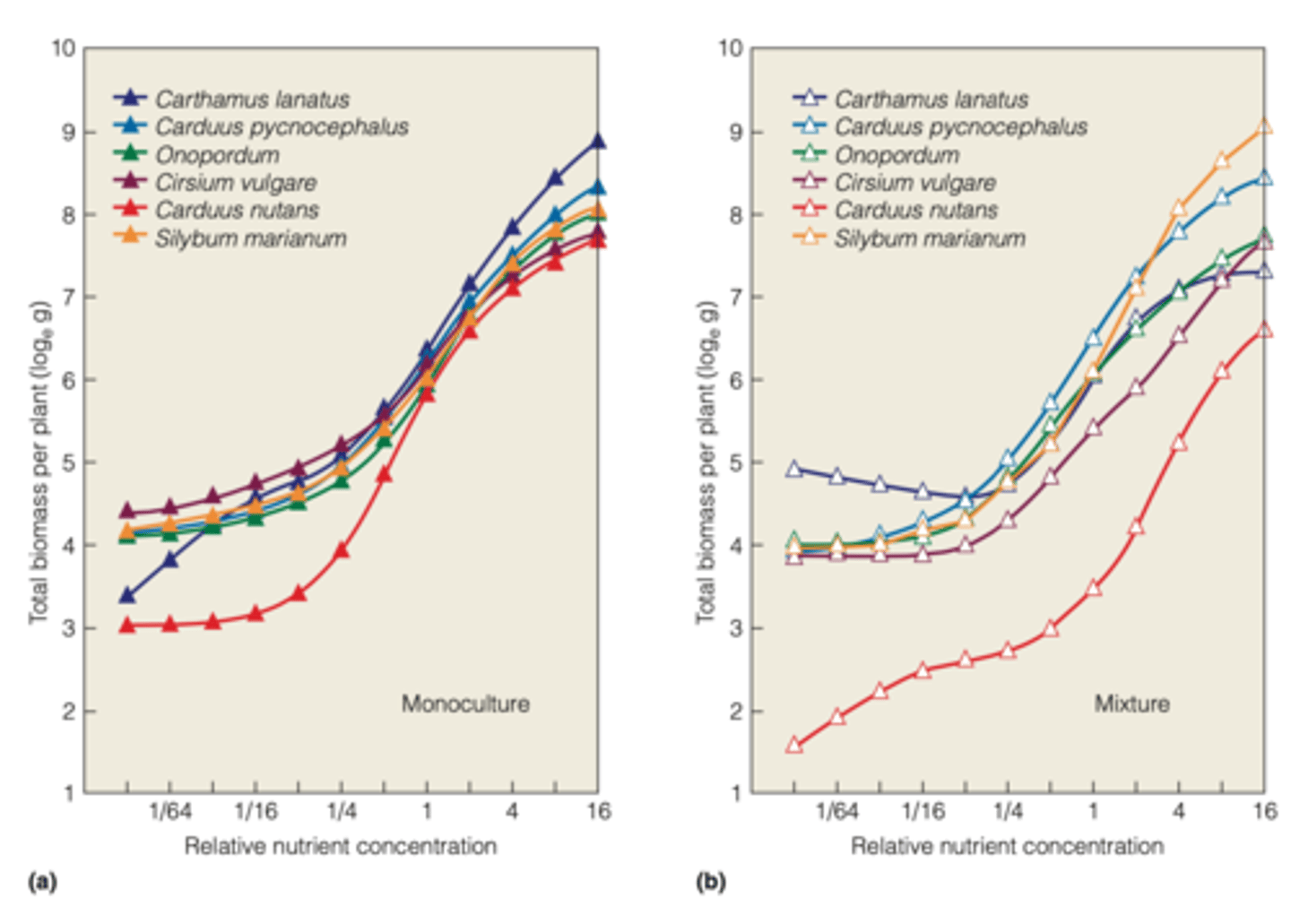
Nutrient gradient changes (Thistle plant EXAMPLE)
WHERE WAS THIS SEEN?
- seen when the response of each species in the mixed experiments was expressed on a relative basis
----------------
HOW WAS IT CALCULATED?
- dividing the biomass value for each species at each nutrient level by the value of the species that achieved the highest biomass at that level
----------------
RESULTS:
- range from 0 to 1.0
- 0 being the worst competitor
- 1 being the best competitor
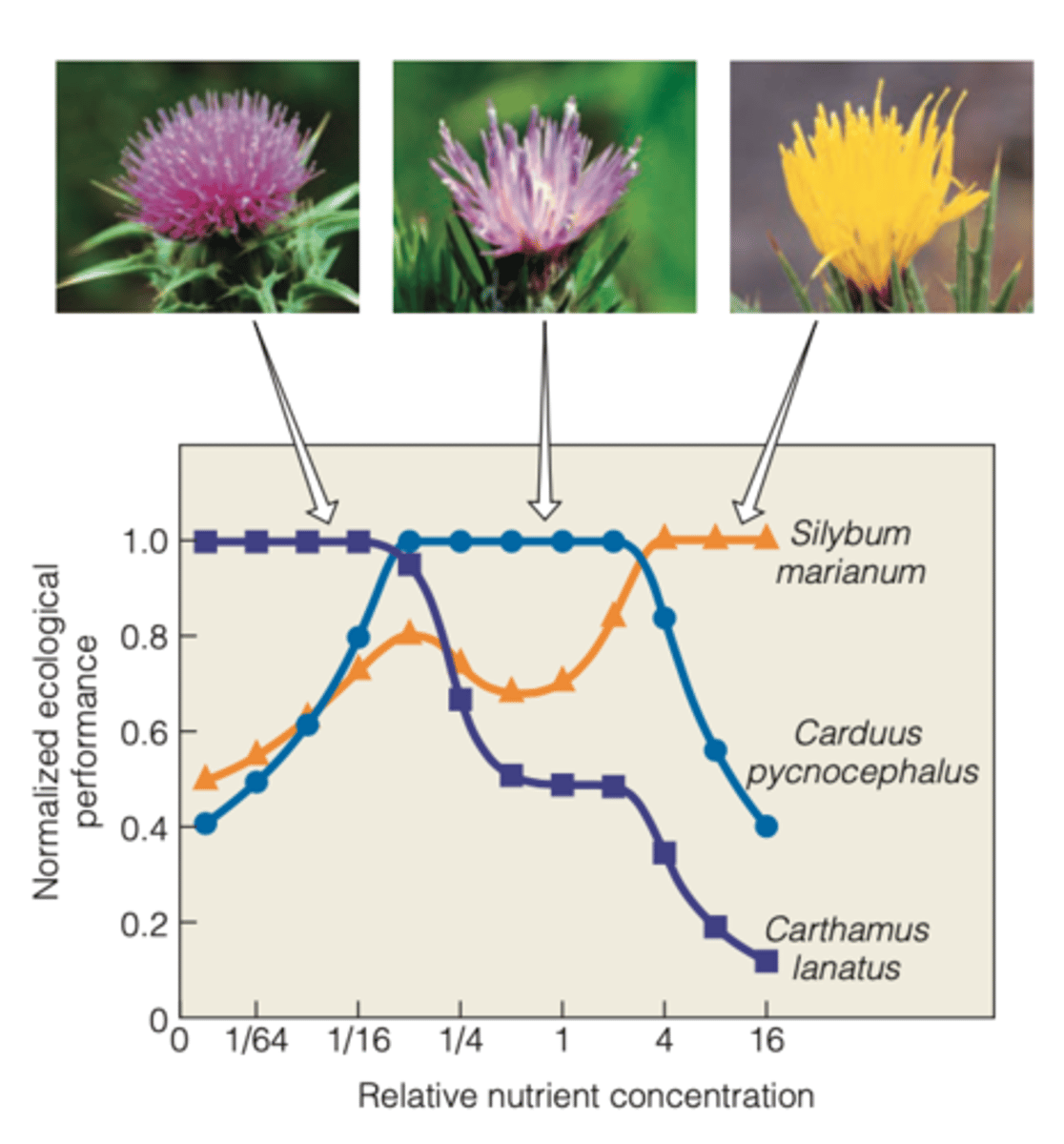
Interaction of competition and tolerance to physical stress
is a good way to determine a species distribution along an environmental gradient.
----------------
EXAMPLE:
- 4 different chipmunks experiment
4 different chipmunks experiment
WHAT DID IT OBSERVE?
- 4 different chipmunks were observed and in each case they had individual cases of aggressive behavior, physiological tolerance, and were restricted to a portion of their distinct habitats
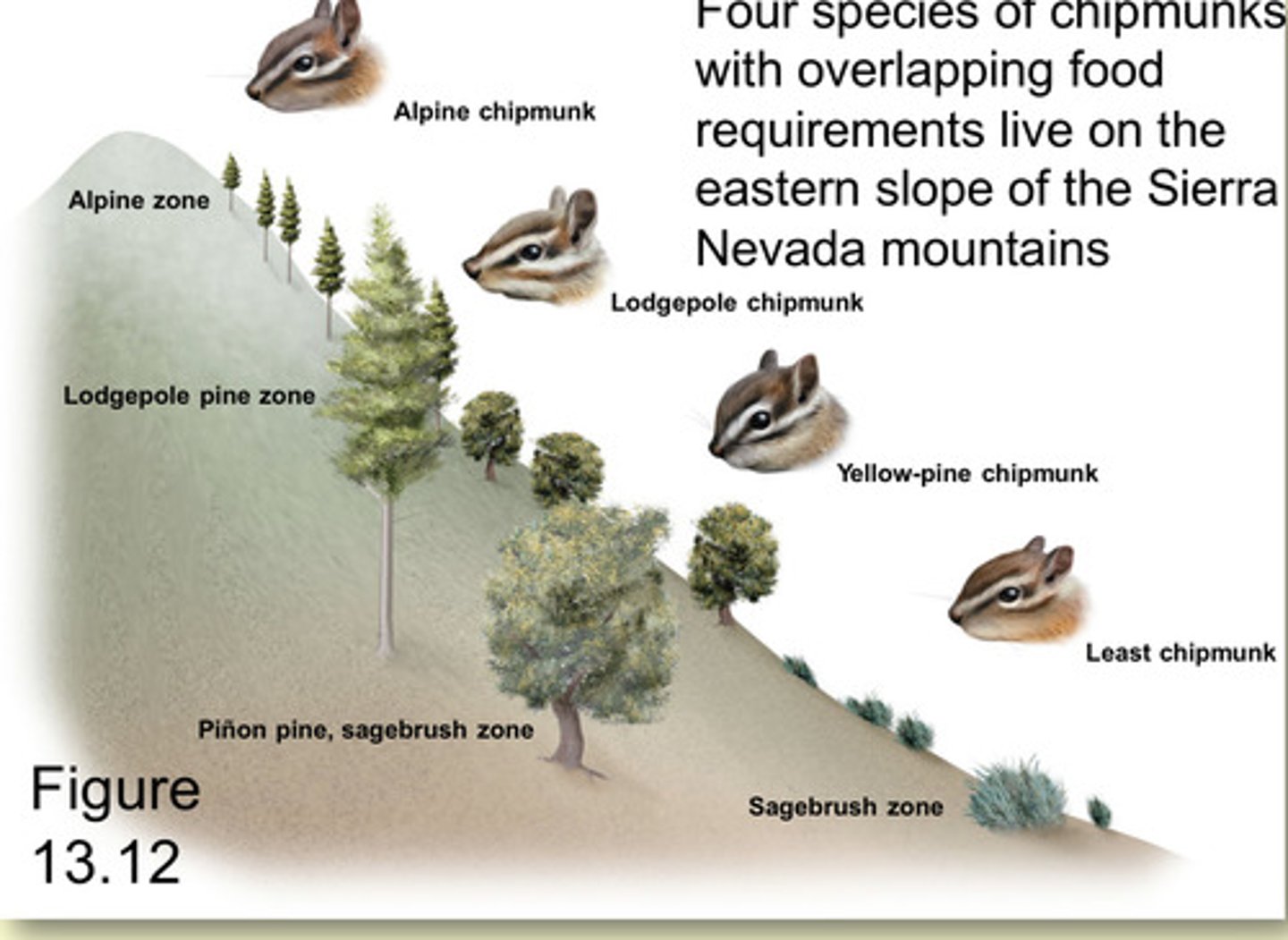
What factors might influence their distribution along the slope? (chipmunks experiment)
There are many possibilities but it was mainly dominance/aggression and thermal biology

The niche of a species includes:
- range of physical and chemical conditions under which it can survive and reproduce
fundemental niche
the range of conditions when there are no interactions with other species
----------------
many studies have demonstrated that the fundamental niche contracts when a competitor is present
realized niche
part of the fundamental niche that a species exploits as a result of interactions with other species
Competitive release
expansion of a species niche when a competitor is no longer present
Competitive release occurs when
- a species invades an island that is free of potential competitors
or
- a species moves into a habitat it never occupied on a mainland and becomes more abundant
Stipa neomexicana plants experiment
WHAT WAS ITS PURPOSE?
- looked at the growth of plants on 3 different slopes
- neighboring plants were removed which impacted the growth rates of some other plants
----------------
RESULTS:
- graph showed distinction between growth rates when one neighboring plant was removed on 1 of the 3 different slopes
- ridge crest showed the least difference
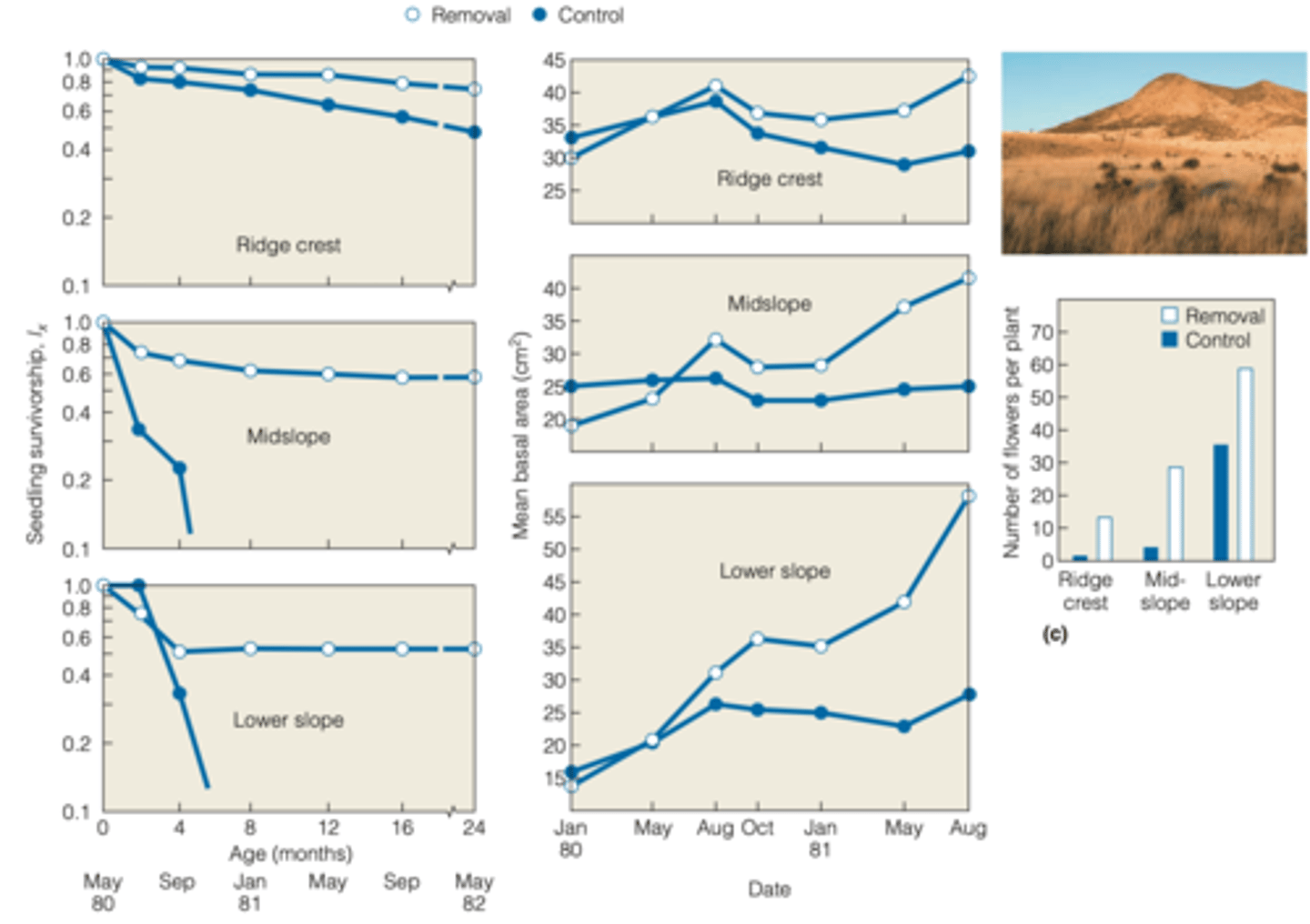
Red Imported Fire Ant (RIFA) experiment
Experiment performed by Dr. S and his colleague
----------------
WHAT WAS THE PURPOSE?
- observed the spread of fire ants on spring island Beaufort County (span of 2 years)
----------------
RESULTS:
- observed nearly 1,300 individual invertebrates
- 20 genera from all four classes of terrestrial vertebrates
- carpenter ants were the dominant native ants
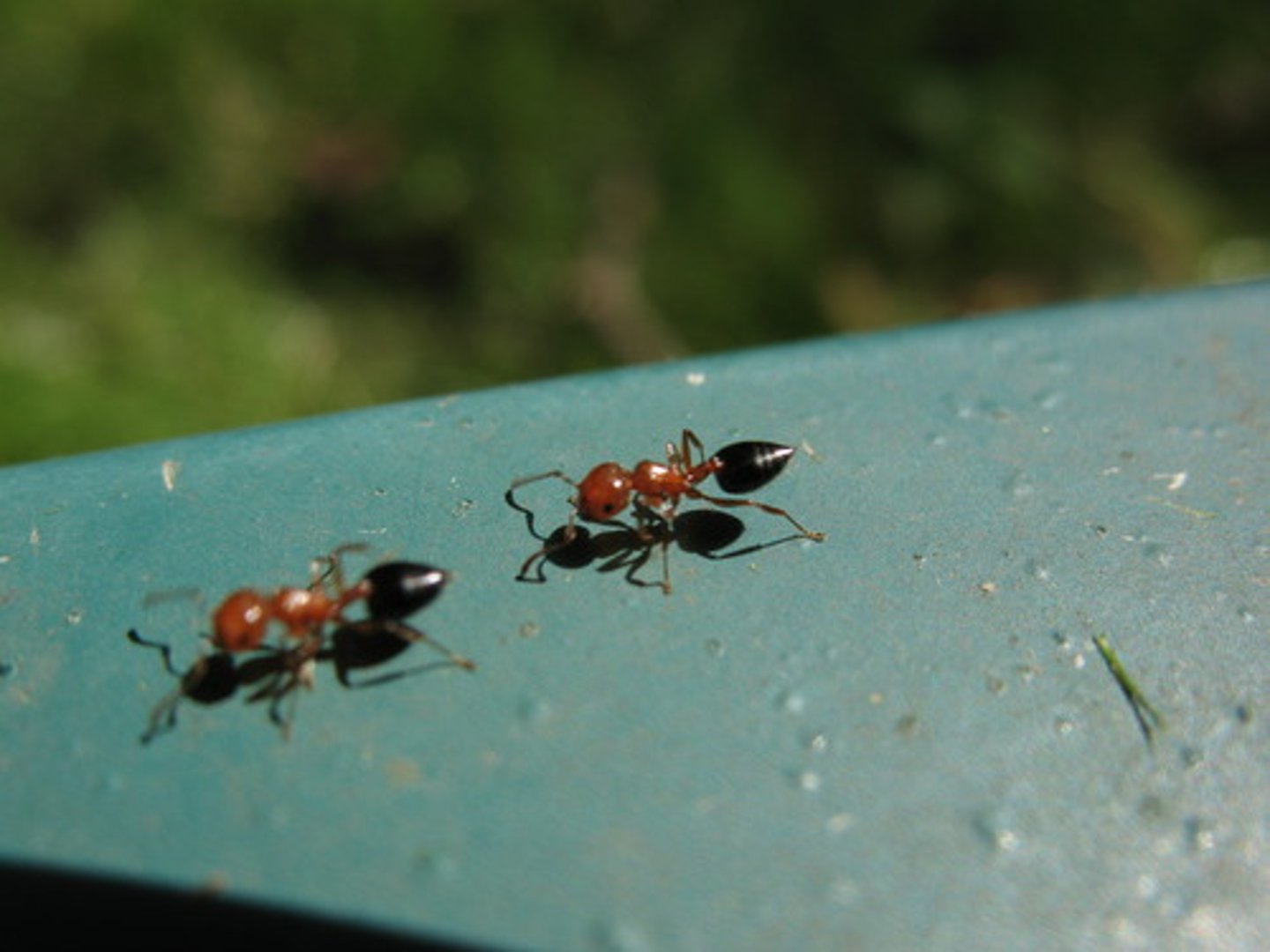
Why are similar species within the same area able to coexist?
they partition the available resources
----------------
IS THIS THE SAME FOR PLANTS?
- no
Why are similar plant species within the same are not able to exist?
plants use nutrients in different proportions and tolerate different light levels
- each plant species uses a portion of the resource not used by the other it lives with
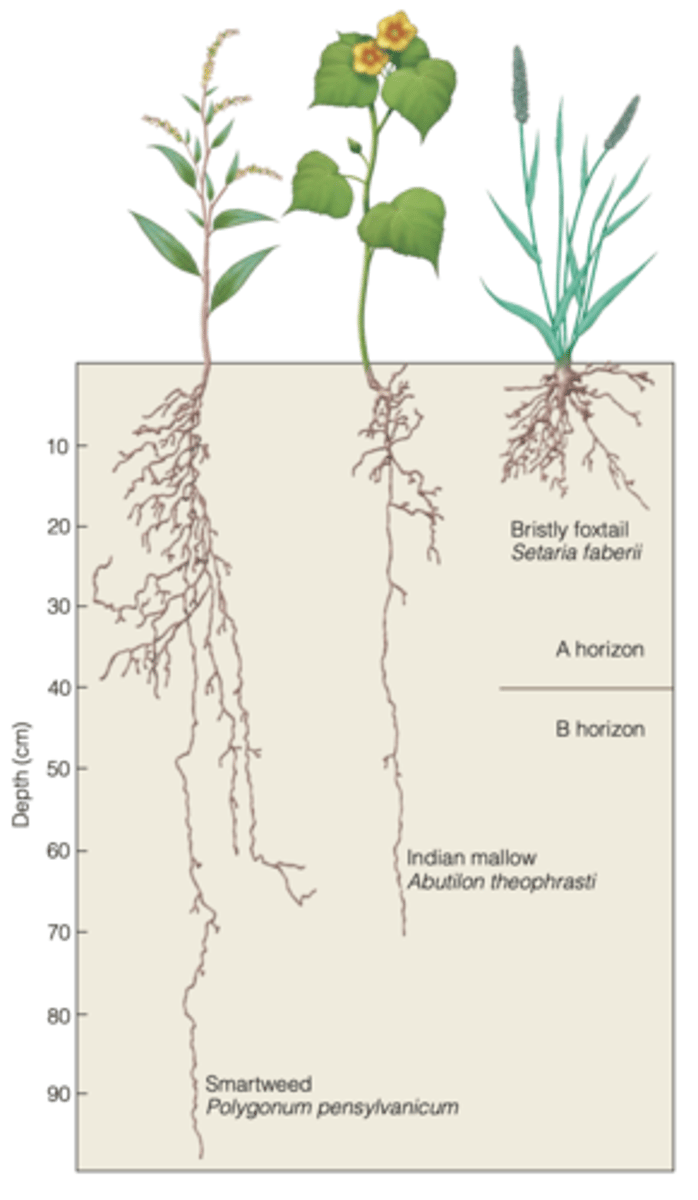
resource partitioning
the differentiation of niches that enables similar species to coexist in a community
----------------
EXPERIMENTS:
- wild cats inhabiting the middle east
Wild cats inhabiting the middle east (EXPERIMENT)
PURPOSE?
- colleagues from the Middle East examined differences among species in the size of canine teeth, which were cricual to wild cats in capturing and killing their prey
----------------
RESULTS:
- found systematic differences in the size of the canine teeth within the same cat species and coexisting cat species.
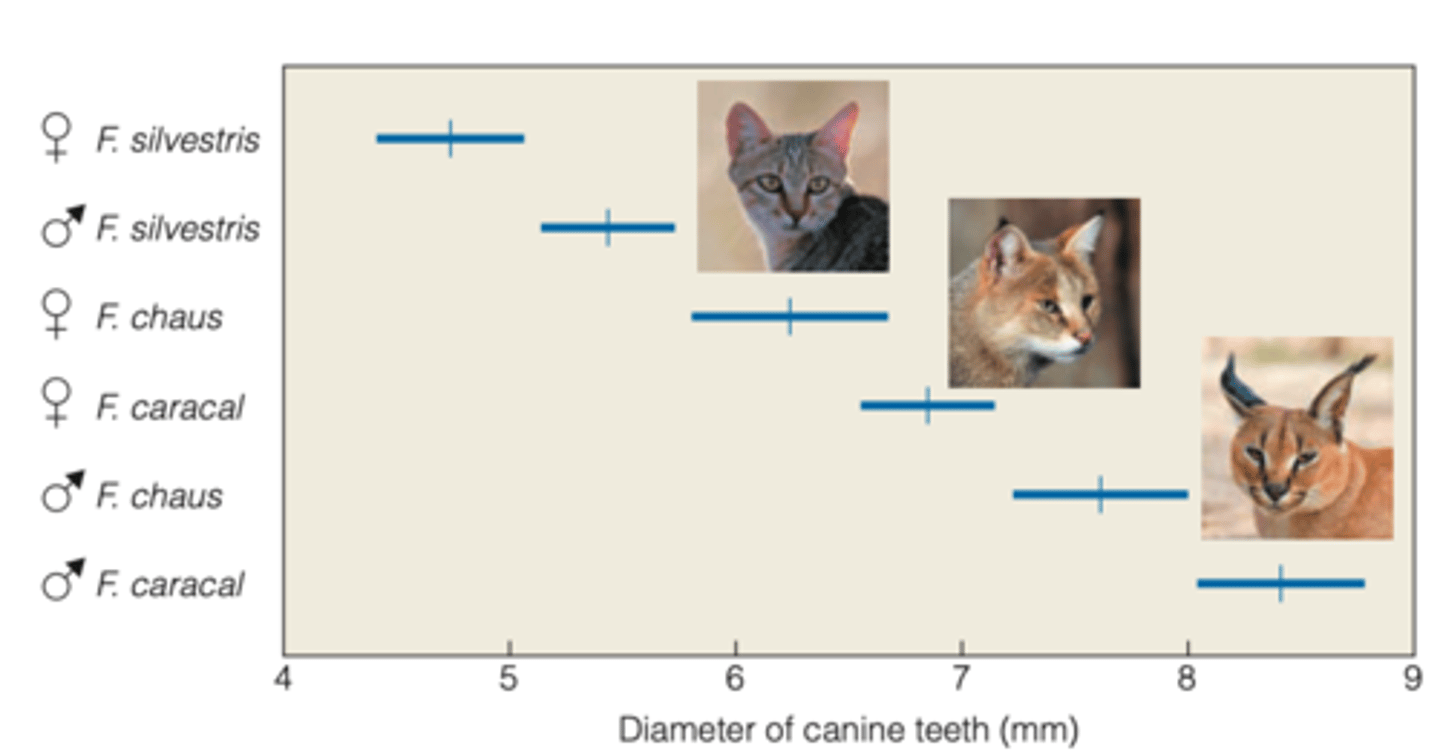
resource partitioning is a result of
differences among co-occurring species in:
- physiological
- morphological
- behavioral adaptions
----------------
EACH ADAPTATION ALLOWS FOR SPECIES TO COEXIST
Is the idea of resource partitioning and the hypothesis of phenotypic divergence related?
Yes
----------------
WHY?
- they are consistent with each other but it is difficult to prove that competition functioned as the agent of natural selection that resulted in the observed differenced in resource use.
- represents the "ghost of competition past"
why is demonstrating competition in the filed more challenging than in a lab
1) field researchers have little control over the environment
2) field reachers have a hard time determining wether a population is at or below the carrying capacity (K)
3) field researchers lack the knowledge of the life history of a species or subtle differences between species
effects of removal experiments
- can have a direct and indirect environmental effects
removing of plants (effects of removal experiments)
- increase the light energy reaching the soil surface, soil temperature, and the evaporation rate
- reduce soil moisture and increase decomposition rate
(affects below ground resources)
How is competition a complex interaction
1.) it involves the interaction of two species interacting for a single resource
2) involves a variety of environmental factors that vary in time and space
3) the outcomes under one set of environmental conditions can be different for another set